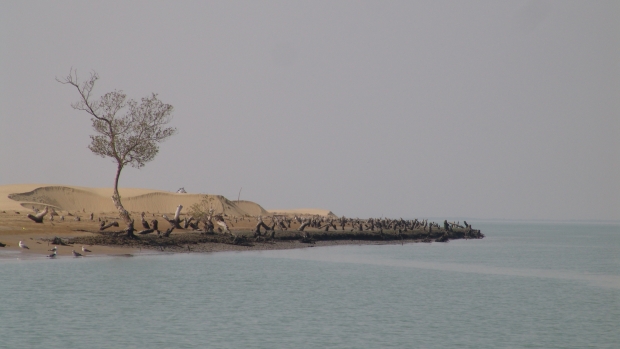Grants :: Small Grant Facilities :: Sand Dune Stabilization for Mangrove Protection in Miani Hor
Sand Dune Stabilization for Mangrove Protection in Miani Hor

Sand Dune Stabilization for Mangrove Protection in Miani Hor
Objectives
- To control sand dune migration by replacing a six hectare area occupied by sand dunes with mangrove plantation strips.
- To conduct a base line survey of the mangrove area being affected by migrating sand dunes.
Background
Miani Hor is a coastal lagoon along the Balochistan coast which is known for the natural occurrence of three species of mangrove, namely Avicennia marina, Ceriops tagal, and Rhizophora mucronata. The local communities residing here are dependent on mangroves for fuel wood and fodder, and also on the fisheries which the mangroves support. While the lagoon’s natural vegetation is being adversely affected due to a number of human factors, such as illegal cutting for firewood and fodder, another factor, which has been given rather less importance, is the migration of sand dunes which are smothering the mangroves in the south and south western area of the lagoon.
The aim of this project is to bring this issue to the forefront and attempt to arrest the migration of sand dunes and restore areas which have already been affected by it. To this end, mangroves will be replanted after an initial survey to assess the areas already affected; awareness will be raised by providing information to stakeholders who can then use this knowledge to further conserve and manage mangroves in this region. University students will also be given the opportunity to study this topic. Awareness will be raised among the local communities in the region which, along with the Balochistan Forest Department, will continue to protect the mangroves once the project activities have been completed.
Target beneficiaries
The communities in Miani Hor, particularly in the towns/settlements of Dam, Sonmiani and Bhera.
Outputs
- Development of an Action Plan.
- Development of an assessment report of the area already affected by sand dune migration.
- Restoration of six hectares of area by planting mangroves in the valleys between sand dunes.
- Digging of 1600 ft long trenches in the valleys with sand dunes to allow sea water to access the area.
Accomplishments and challenges
- 1600 ft trenches have been dug to facilitate seawater spreading in the valleys between sand dunes.
- Mangroves were planted over six hectares area.
- An assessment report and action plan developed for arresting sand dune shifting affecting mangroves which was shared with Balochistan Forest Department and other stakeholders.
- The project engaged local communities and the Balochistan Forest Department and other relevant agencies to create awareness regarding the impacts of sand dune migration.
- Obtaining historical information about mangrove cover has been difficult, as this information is not readily available.
Contributions to cross-cutting themes
Communications
Project brochures published.
Gender Equality
No particular emphasis on the topic of gender equality in this project, though some mention is made of recognising the differences between men and women with respect to access to, and use of, resources, means of production and income generation.
Climate Change
The restoration of six hectares of mangroves will result in better resilience to climate change for communities along the coast
Lessons Learned
- Project drew attentions of stakeholders towards encroachment of mangroves by sand dune migration in Sonmiani area of Balochistan.
- Smothering of mangroves by sand dunes is the most serious threat to the mangroves in the Miani Hor area. The project estimated that more than 3.6 square km of mangroves have been wiped out whereas in about 2.1 square km mangrove root system is being smothered by migrating sand dunes.
- Gut area of Maini Hor was most affected. In the northern part of Gut, total area of mangrove buried under sand dune between 2004 and 2013 was estimated to be 0.275 sq. km. In the southern part of the area covered in the same period is calculated to be 0.16 km.
- The plantation of mangroves in the valleys between sand dunes could be one of the ways of stopping sand dunes migration. Restoration of mangroves would help in increasing plant cover in the area which is a positive step to deal with the impacts of climate change.
Project Facts
Country
Location
Maini Hor, Lasbela District, Balochistan
Topic
Duration
5th Jul 2013 to 5th May 2014
MFF Grant Amount
PKR 972,800
Implementing Partner
Coastal Association for Research and Development (CARD)
Muhammad Anwar Mundra
Email: card.org.pk@gmail.com